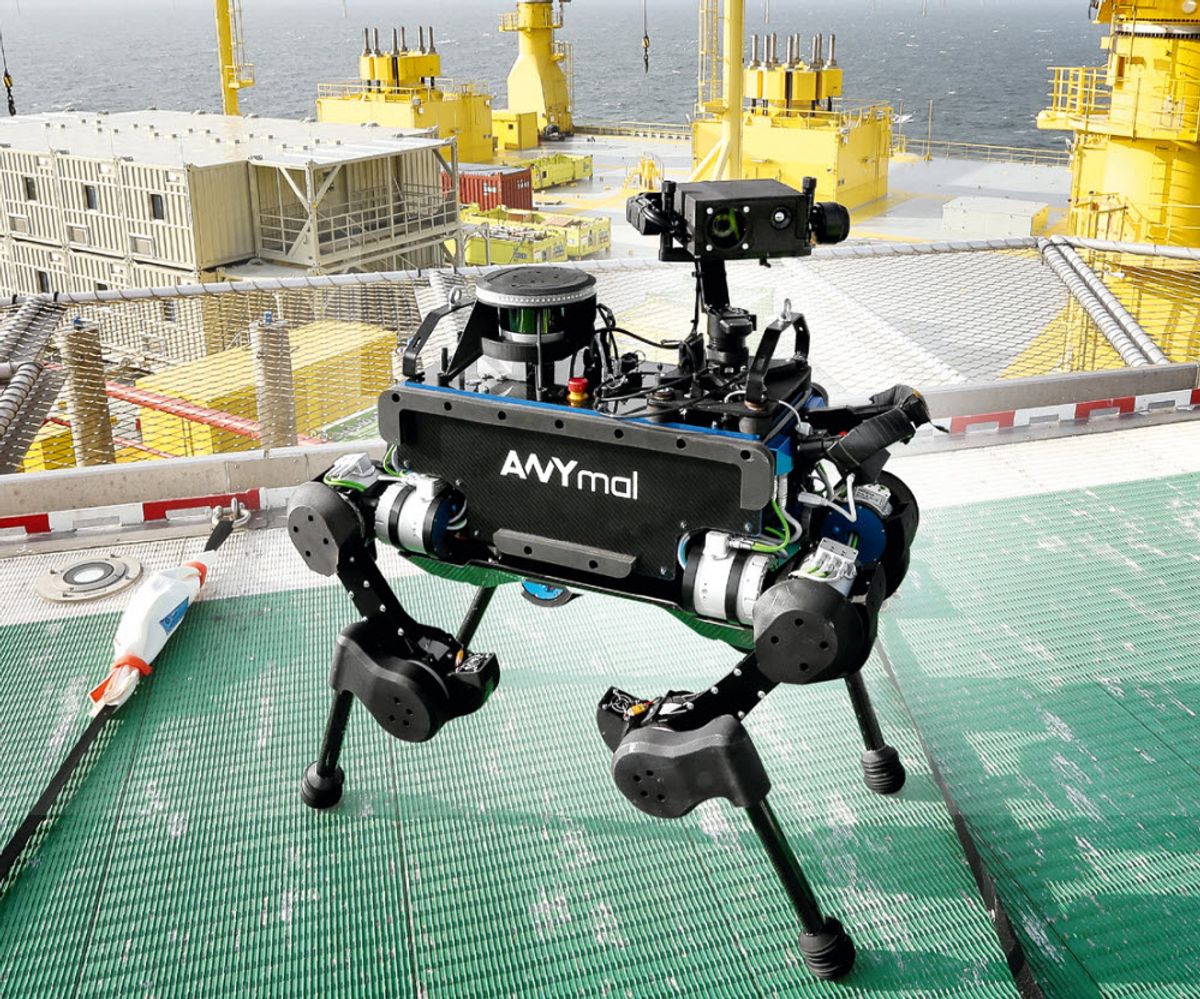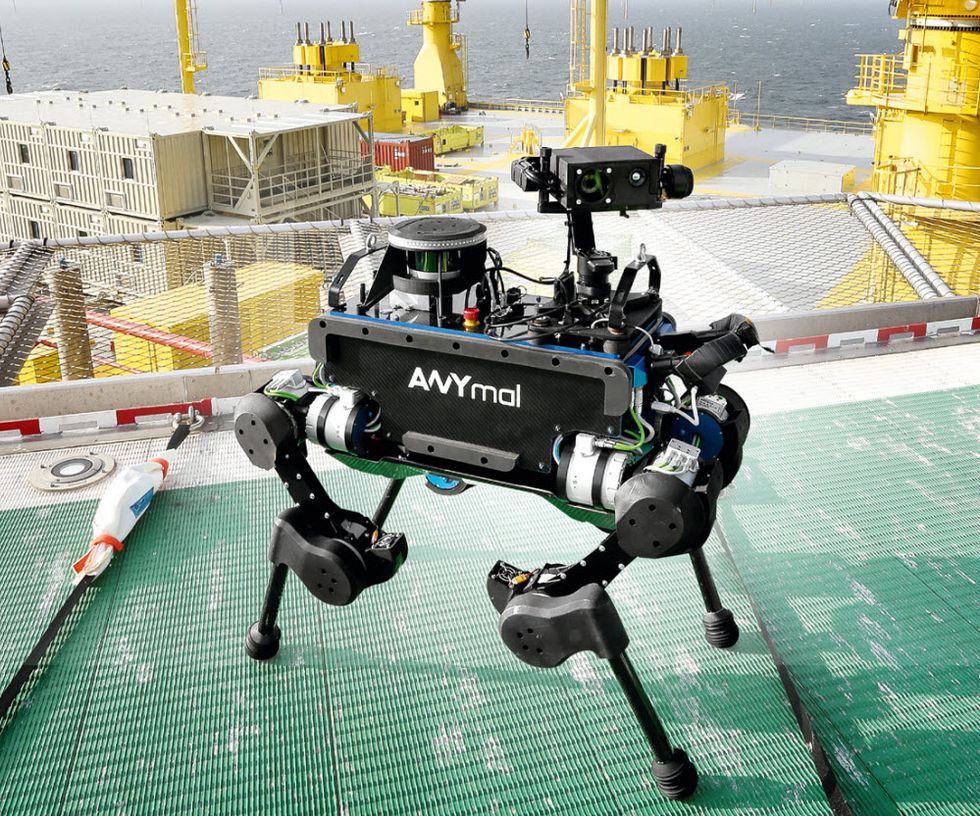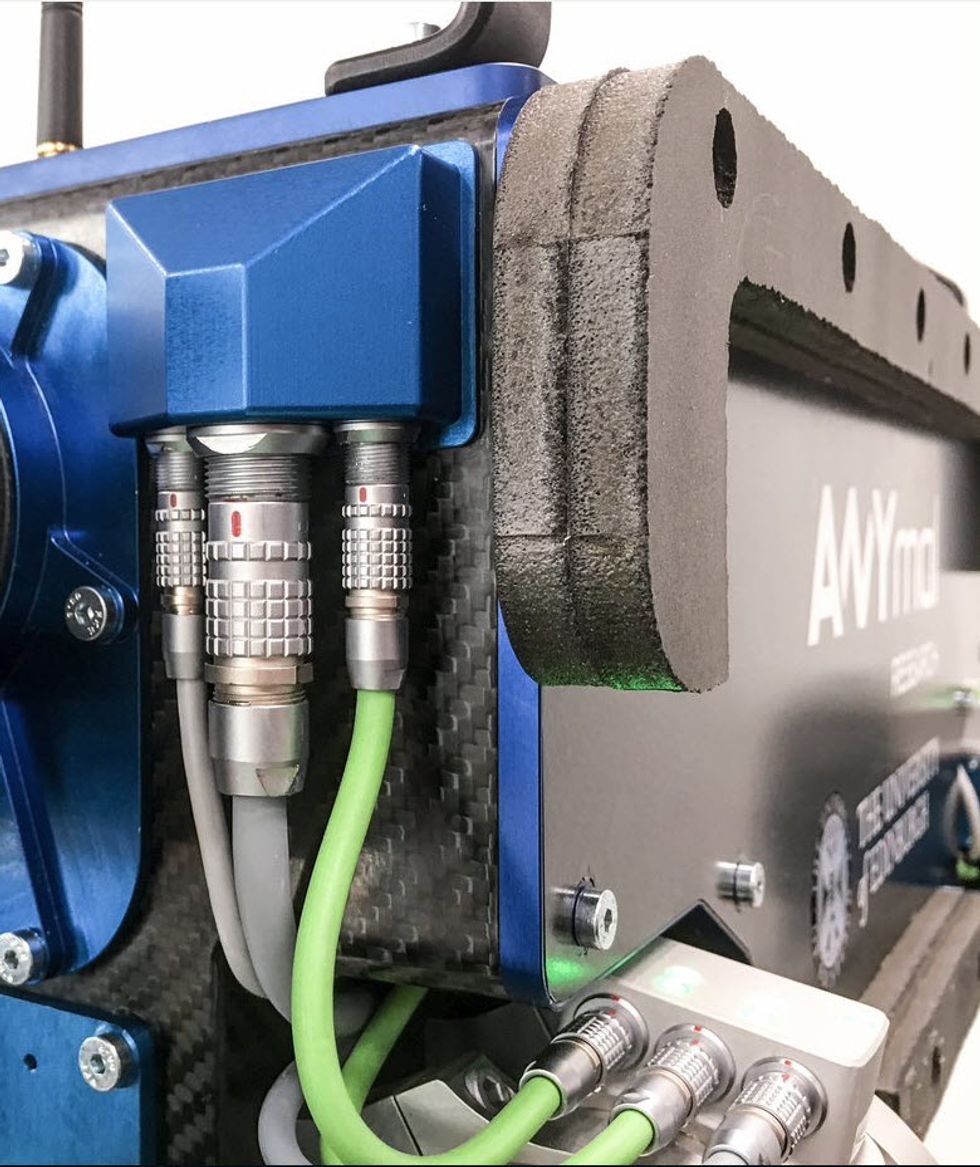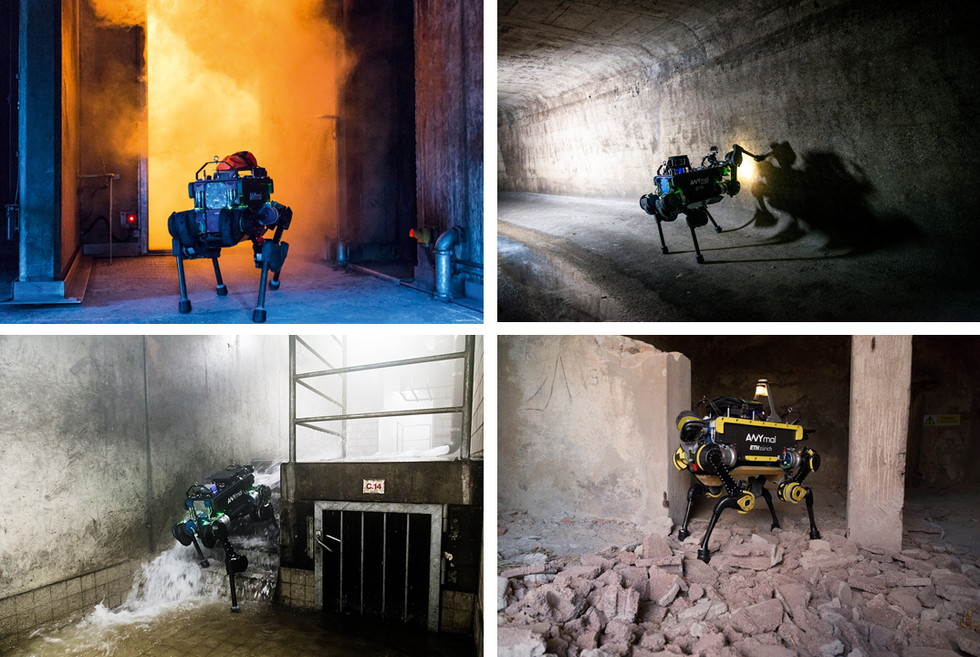An off-shore wind power platform, somewhere in the North Sea, on a freezing cold night, with howling winds and waves crashing against the impressive structure. An imperturbable ANYmal is quietly conducting its inspection.
ANYmal, a medium sized dog-like quadruped robot, walks down the stairs, lifts a “paw” to open doors or to call the elevator and trots along corridors. Darkness is no problem: it knows the place perfectly, having 3D-mapped it. Its laser sensors keep it informed about its precise path, location and potential obstacles. It conducts its inspection across several rooms. Its cameras zoom in on counters, recording the measurements displayed. Its thermal sensors record the temperature of machines and equipment and its ultrasound microphone checks for potential gas leaks. The robot also inspects lever positions as well as the correct positioning of regulatory fire extinguishers. As the electronic buzz of its engines resumes, it carries on working tirelessly.
After a little over two hours of inspection, the robot returns to its docking station for recharging. It will soon head back out to conduct its next solitary patrol. ANYmal played alongside Mulder and Scully in the “X-Files” TV series*, but it is in no way a Hollywood robot. It genuinely exists and surveillance missions are part of its very near future.
Off-shore oil platforms, the first test fields and probably the first actual application of ANYmal. ©ANYbotics
This quadruped robot was designed by ANYbotics, a spinoff of the Swiss Federal Institute of Technology in Zurich (ETH Zurich). Made of carbon fibre and aluminium, it weighs about thirty kilos. It is fully ruggedised, water- and dust-proof (IP-67). A kevlar belly protects its main body, carrying its powerful brain, batteries, network device, power management system and navigational systems.
ANYmal was designed for all types of terrain, including rubble, sand or snow. It has been field tested on industrial sites and is at ease with new obstacles to overcome (and it can even get up after a fall). Depending on its mission, its batteries last 2 to 4 hours.
On its jointed legs, protected by rubber pads, it can walk (at the speed of human steps), trot, climb, curl upon itself to crawl, carry a load or even jump and dance. It is the need to move on all surfaces that has driven its designers to choose a quadruped. “Biped robots are not easy to stabilise, especially on irregular terrain” explains Dr Péter Fankhauser, co-founder and chief business development officer of ANYbotics. “Wheeled or tracked robots can carry heavy loads, but they are bulky and less agile. Flying drones are highly mobile, but cannot carry load, handle objects or operate in bad weather conditions. We believe that quadrupeds combine the optimal characteristics, both in terms of mobility and versatility.”
What served as a source of inspiration for the team behind the project, the Robotic Systems Lab of the ETH Zurich, is a champion of agility on rugged terrain: the mountain goat. “We are of course still a long way” says Fankhauser. “However, it remains our objective on the longer term.
The first prototype, ALoF, was designed already back in 2009. It was still rather slow, very rigid and clumsy – more of a proof of concept than a robot ready for application. In 2012, StarlETH, fitted with spring joints, could hop, jump and climb. It was with this robot that the team started participating in 2014 in ARGOS, a full-scale challenge, launched by the Total oil group. The idea was to present a robot capable of inspecting an off-shore drilling station autonomously.
Up against dozens of competitors, the ETH Zurich team was the only team to enter the competition with such a quadrupedal robot. They didn’t win, but the multiple field tests were growing evermore convincing. Especially because, during the challenge, the team designed new joints with elastic actuators made in-house. These joints, inspired by tendons and muscles, are compact, sealed and include their own custom control electronics. They can regulate joint torque, position and impedance directly. Thanks to this innovation, the team could enter the same competition with a new version of its robot, ANYmal, fitted with three joints on each leg.
The ARGOS experience confirms the relevance of the selected means of locomotion. “Our robot is lighter, takes up less space on site and it is less noisy” says Fankhauser. “It also overcomes bigger obstacles than larger wheeled or tracked robots!” As ANYmal generated public interest and its transformation into a genuine product seemed more than possible, the startup ANYbotics was launched in 2016. It sold not only its robot, but also its revolutionary joints, called ANYdrive.
Today, ANYmal is not yet ready for sale to companies. However, ANYbotics has a growing number of partnerships with several industries, testing the robot for a few days or several weeks, for all types of tasks. Last October, for example, ANYmal navigated its way through the dark sewage system of the city of Zurich in order to test its capacity to help workers in similar difficult, repetitive and even dangerous tasks.
Why such an early interest among companies? “Because many companies want to integrate robots into their maintenance tasks” answers Fankhauser. “With ANYmal, they can actually evaluate its feasibility and plan their strategy. Eventually, both the architecture and the equipment of buildings could be rethought to be adapted to these maintenance robots”.
ANYmal requires ruggedised, sealed and extremely reliable interconnection solutions, such as LEMO. ©ANYbotics
Through field demonstrations and testing, ANYbotics can gather masses of information (up to 50,000 measurements are recorded every second during each test!) “It helps us to shape the product.” In due time, the startup will be ready to deliver a commercial product which really caters for companies’ needs.
Inspection and surveillance tasks on industrial sites are not the only applications considered. The startup is also thinking of agricultural inspections – with its onboard sensors, ANYmal is capable of mapping its environment, measuring bio mass and even taking soil samples. In the longer term, it could also be used for search and rescue operations. By the way, the robot can already be switched to “remote control” mode at any time and can be easily tele-operated. It is also capable of live audio and video transmission.
The transition from the prototype to the marketed product stage will involve a number of further developments. These include increasing ANYmal’s agility and speed, extending its capacity to map large-scale environments, improving safety, security, user handling and integrating the system with the customer’s data management software. It will also be necessary to enhance the robot’s reliability “so that it can work for days, weeks, or even months without human supervision.” All required certifications will have to be obtained. The locomotion system, which had triggered the whole business, is only one of a number of considerations of ANYbotics.
Designed for extreme environments, for ANYmal smoke is not a problem and it can walk in the snow, through rubble or in water. ©ANYbotics
The startup is not all alone. In fact, it has sold ANYmal robots to a dozen major universities who use them to develop their know-how in robotics. The startup has also founded ANYmal Research, a community including members such as Toyota Research Institute, the German Aerospace Center and the computer company Nvidia. Members have full access to ANYmal’s control software, simulations and documentation. Sharing has boosted both software and hardware ideas and developments (built on ROS, the open-source Robot Operating System). In particular, payload variations, providing for expandability and scalability. For instance, one of the universities uses a robotic arm which enables ANYmal to grasp or handle objects and open doors.
Among possible applications, ANYbotics mentions entertainment. It is not only about playing in more films or TV series, but rather about participating in various attractions (trade shows, museums, etc.). “ANYmal is so novel that it attracts a great amount of interest” confirms Fankhauser with a smile. “Whenever we present it somewhere, people gather around.”
Videos of these events show a fascinated and sometimes slightly fearful audience, when ANYmal gets too close to them. Is it fear of the “bad robot”? “This fear exists indeed and we are happy to be able to use ANYmal also to promote public awareness towards robotics and robots.” Reminiscent of a young dog, ANYmal is truly adapted for the purpose.
However, Péter Fankhauser softens the image of humans and sophisticated robots living together. “These coming years, robots will continue to work in the background, like they have for a long time in factories. Then, they will be used in public places in a selective and targeted way, for instance for dangerous missions. We will need to wait another ten years before animal-like robots, such as ANYmal will share our everyday lives!”
At the Consumer Electronics Show (CES) in Las Vegas in January, Continental, the German automotive manufacturing company, used robots to demonstrate a last-mile delivery. It showed ANYmal getting out of an autonomous vehicle with a parcel, climbing onto the front porch, lifting a paw to ring the doorbell, depositing the parcel before getting back into the vehicle. This futuristic image seems very close indeed.
*X-Files, season 11, episode 7, aired in February 2018






